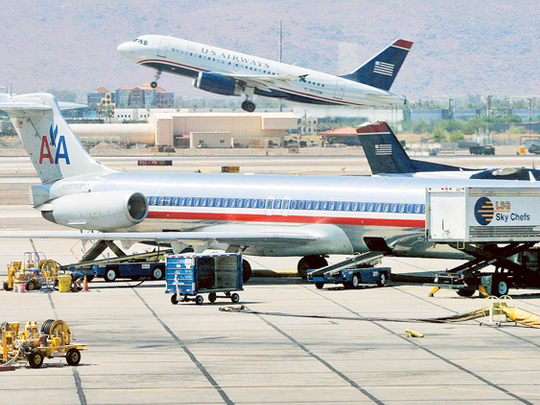
Dallas: American Airlines and US Airways have agreed to a merger that will create the world's biggest airline. The deal caps a turbulent period of bankruptcies and consolidation that leaves the US airline industry dominated by four big carriers.
The boards of American parent AMR Corp. and US Airways approved the deal late Wednesday, according to four people close to the situation.
The carrier will keep the American Airlines name but will be run by US Airways CEO Doug Parker. American's CEO, Tom Horton, will serve as chairman of the new company until mid-2014, these people said. They requested anonymity because the merger negotiations were private.
The deal has been in the works since August, when creditors pushed for merger talks so they could decide which earned them a better return: a merger or Horton's plan for an independent airline. American has been restructuring under bankruptcy protection since late 2011. AMR creditors and possibly its shareholders will own 72 per cent of the stock, and US Airways Group Inc. shareholders will get the rest, three of the people said.
A formal announcement is expected on Thursday.
If the deal is approved by AMR's bankruptcy judge and antitrust regulators, the new American will have more than 900 planes, 3,200 daily flights and about 95,000 employees, not counting regional affiliates. It will be slightly bigger than United Airlines by passenger traffic.
Since 2008, Delta gobbled up Northwest, United absorbed Continental and Southwest bought AirTran Airways. If this latest merger goes through, American, United, Delta and Southwest will control about three-quarters of US airline traffic.
The rapid consolidation has allowed the surviving airlines to offer bigger route networks that appeal to high-paying business travelers. And it has allowed them to limit the supply of seats, which helps prop up fares and airline profits.
Word of an American-US Airways merger raised new concern among passenger advocates. Charles Leocha of the Consumer Travel Alliance said that with just four big airlines instead of five, it will be easier to raise fares. "The benefits of this deal will go only to the corporations, not to consumers," he said.
But industry officials say there will still be plenty of competition. A recent study by PricewaterhouseCoopers found that adjusting for inflation, domestic US airfares fell 1 per cent between 2004 and 2011, a period that included several airline mergers.
Travellers on American and US Airways won't notice immediate changes. It likely will be months before the frequent-flier programmes are combined and years before the two airlines are fully integrated.
When that happens, American's presence will grow in key East Coast markets including New York's LaGuardia Airport and Washington's Reagan National Airport. The merger will add US Airways hubs in Charlotte, Philadelphia and Phoenix to American's in Dallas-Fort Worth, Chicago, Miami, New York and Los Angeles.
US Airways will boost American's service to Europe and the Latin America-Caribbean market but wouldn't fix American's weakness on routes to Asia.












